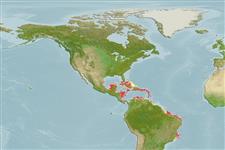Common names from other countries
>
Anguilliformes (Eels and morays) >
Ophichthidae (Snake eels) > Ophichthinae
Etymology: Myrichthys: Greek, myros, -ou = male of morey eel + Greek, ichthys = fish (Ref. 45335).
More on author: Lesueur.
Environment: milieu / climate zone / depth range / distribution range
Οικολογία
Θαλασσινό(ά) Υφαλόφιλο(α); εύρος βάθους ? - 15 m (Ref. 58018). Tropical; 25°N - 23°S
Western Atlantic: Bermuda, southern Florida (USA), and Bahamas to Santa Catarina, Brazil (Ref. 57756). Eastern Atlantic.
Μέγεθος / Βάρος / Age
Maturity: Lm ? range ? - ? cm
Max length : 110 cm TL αρσενικό/απροσδιόριστο; (Ref. 26938)
With diffuse dark spots, each with a pale center (bright yellow in life), on a pale tan or greenish-brown background, shading to pale green ventrally (Ref. 26938).
Common near islands and in rocky or coral areas (Ref. 7251). May move beneath the sand (Ref. 9710). Found in seagrass bed sand areas with sand and coral rubble (Ref. 26938). Feeds mainly on crabs (Ref. 32). Forages at night for prey.
Life cycle and mating behavior
Maturities | Αναπαραγωγή | Spawnings | Egg(s) | Fecundities | Προνύμφες
Robins, C.R., R.M. Bailey, C.E. Bond, J.R. Brooker, E.A. Lachner, R.N. Lea and W.B. Scott, 1991. Common and scientific names of fishes from the United States and Canada. Am. Fish. Soc. Spec. Publ. (20):183 p. (Ref. 3814)
IUCN Red List Status (Ref. 130435)
CITES (Ref. 128078)
Not Evaluated
Threat to humans
Harmless
Human uses
αλιεία: Εμπορικό(ά); Ενυδρείο: Εμπορικό(ά)
Εργαλεία
Special reports
Download XML
Διαδικτυακές πηγές
Estimates based on models
Preferred temperature (Ref.
115969): 26.5 - 28.2, mean 27.5 (based on 632 cells).
Phylogenetic diversity index (Ref.
82804): PD
50 = 0.5005 [Uniqueness, from 0.5 = low to 2.0 = high].
Bayesian length-weight: a=0.00089 (0.00039 - 0.00204), b=3.00 (2.80 - 3.20), in cm Total Length, based on LWR estimates for this (Sub)family-body shape (Ref.
93245).
Τροφικό Επίπεδο (Ref.
69278): 3.6 ±0.4 se; based on diet studies.
Ελαστικότητα (Ref.
120179): Μεσαίο(α), ελάχιστος χρόνος για διπλασιασμό πληθυσμού 1,4 - 4,4 έτη (Preliminary K or Fecundity.).
Fishing Vulnerability (Ref.
59153): High to very high vulnerability (66 of 100).
